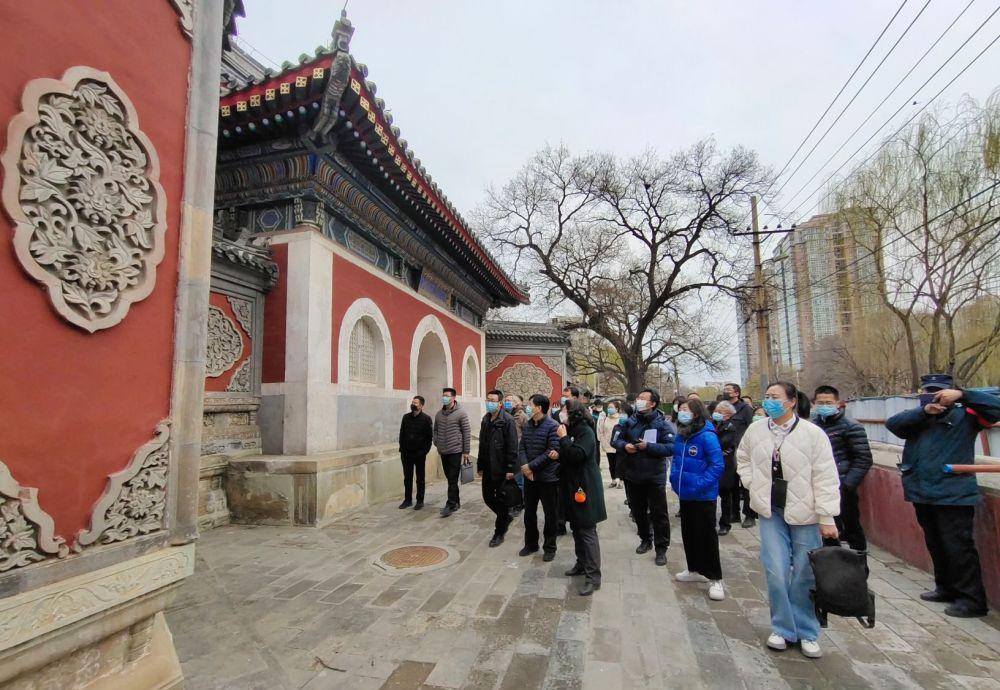Speaking of the Beijing Art Museum, you may be a little unfamiliar, but when it comes to the Wanshou Temple, an ancient temple in the Ming and Qing dynasties where the museum is located, you may understand that it was the famous royal birthday celebration field - the Qianlong Emperor once wished his mother a birthday in the temple, and Empress Dowager Cixi also held a grand Buddhist event here on her sixtieth birthday. On March 22, the research team of the Beijing Municipal Committee of the Chinese People's Political Consultative Conference "Promoting the Construction of a 'City of Museums' to Help build a National Cultural Center" came to the Beijing Art Museum to investigate. The reporter learned that the ancient building complex of Wanshou Temple, which has been repaired for more than 4 years, is expected to reopen within this year.
In front of the gate of The Manjussa Temple, the long river flows quietly. The deceased is like a sif, not giving up day and night. In front of the pier of Wanshou Temple, it seems that the Qianlong Emperor's dragon boat is still parked, and he left as many as 46 poems here in his lifetime. The plaque above the stone gate ticket of the Mountain Gate Hall of shunzhi in the second year of Shunzhi "Xun Jian Hu Guo Wanshou Temple" is somewhat mottled.
Wanshou Temple ancient building complex is located in Haidian District Zizhu Bridge North, was built in the fifth year of the Ming Dynasty (1577 AD), currently covers an area of 34,000 square meters, construction area of 12,000 square meters, the courtyard buildings are divided into middle, east and west three roads, in 2006 was listed as a national key cultural relics protection unit, has the reputation of "Beijing West Small Forbidden City". The famous Yongle Bell was once hung in the Wanshou Temple. The Beijing Art Museum is located in the Wanshou Temple, officially established in 1987, and is a comprehensive art museum in Beijing.
CppcC members first visited the East Road, which is being repaired. Because it was inhabited for many years before the retreat, the ground of East Road has been raised by about one meter higher than in the Ming and Qing dynasties, and the repair process will restore the height of the ground when the building was built.

Wang Dan, director of the Beijing Art Museum, said that there were "unexpected surprises" in the renovation process: when cleaning up the dirt under the ruins of a Qing Dynasty weeping flower gate, a four-section Huabiao was found, huabiao was ming dynasty, and the eight-sided Huabiao pillar was carved with grass flowers and dragons and curly grass flowers, and the top of the Huabiao was crouched with unicorns (roar). In front of the Tenno hall of Wanshou Temple, there is a huge Dan Majesty Stone, which is the rectangular stone inlaid in the middle of the front steps of the ancient palace, which was also excavated during this round of repairs.
Wang Dan introduced that during the repair of Wanshou Temple, some wooden components, brick and tile components, and ridge decoration components were replaced and replaced, and some component fragments were excavated. After the reopening of the Beijing Art Museum, an exhibition of the architectural components of the Wanshou Temple will be arranged at the back eaves wall of the Great Zen Hall, the largest of which is the third girder replaced by the "beams for columns" during the renovation of the Wanfo Building.
The Beijing Art Museum now collects about 120,000 pieces of various types of art from all over the centuries, from primitive society to the Republic of China, with a wide range of collections, including inscriptions, calligraphy and paintings, ceramics, coins, seals, court embroidery, Ming and Qing dynasty furniture, bronze, jade, bamboo and wood tooth horns, lacquerware and other arts and crafts. Since its completion, Wanshou Temple has a history of nearly 450 years, and the buildings, paintings and Buddha statues in the temple need to be restored. In March 2018, Wanshou Temple began its fifth large-scale renovation in history, the largest and longest overall conservation and restoration project since the 1893 Celebration of Empress Dowager Cixi.com.
After the field investigation of the protection and repair of the ancient building complex of Wanshou Temple, the members of the research group held a discussion with the Beijing Automobile Museum, the Changping District Cultural Relics Management Office, the Tongzhou District Museum, the Miyun District Museum, the Shijingshan District Museum and the Yongdinghe Cultural Museum in Mentougou on the theme of "Stimulating the Vitality of District-level Museums and Improving the Efficiency of Public Services" to exchange views on the positioning, collections, exhibition space, sustainable development, staffing, digitization and other issues of district-level museums, in order to build a "City of Museums" Actively offer advice.